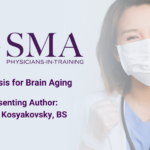Abstract | May 7, 2021
The Basis for Brain Aging
Learning Objectives
- Explain the spectrum of brain aging across the population;
- Discuss the spectrum of pathological and functional change across a number of neurodegenerative diseases with an emphasis on their commonalities and overlap;
- Describe the complex pathophysiology of Alzheimer disease including how the Alzheimer spectrum can be explained by amyloid-tau interaction theory, reconciling existing theories.
Knowledge Gap:
Human brain aging is a true spectrum across the population, ranging from minimal changes on the microscopic level to full-blown neurodegenerative disease with accumulation of pathology, neuronal loss, dysfunctional large-scale brain networks, and progressive functional decline. Although much is known about the individual mechanisms involved in brain aging, a convincing framework that ties these highly related processes together is lacking.
Methods:
Herein, using mathematical modeling, I sought to find a common basis for decline with brain aging by capturing the essential macro-level processes that shape how a brain changes over the lifetime. I develop ABC (Aging Brain Capital), a linear simultaneous equation model that unites aspects of neuroscience, economics, and thermodynamics to explain the evolution of human brain capital, the infrastructure and processes that underlie brain function, over the lifespan.
Results:
The results of this model explain that aging-associated decline in brain function is inevitable, driven by the finite nature of the brain’s pathology-clearance capacity. I suggest that age-related neurodegenerative diseases are in common driven by this general process of aging, explaining the spectrum of pathology accumulation and neurodegeneration across the population. I demonstrate that the complex pathogenesis of Alzheimer disease (AD) can be likewise explained in this framework by integrating amyloid-tau interaction, the emerging concept that amyloid pathology accelerates tau pathology. This conception of Alzheimer pathogenesis not only explains and unifies the basis for familial AD, primary-age-related tauopathy (PART), and late-onset AD (LOAD), but also reconciles amyloid-centered, tau-centered, and synergistic models of AD. Finally, I describe the possible implications of these results for future therapeutic development across neurodegenerative disease.
Conclusions:
Synthesizing the breadth of brain aging research, I create a mathematical model from which a convincing, overarching framework for neurodegenerative disease pathophysiology emerges.

